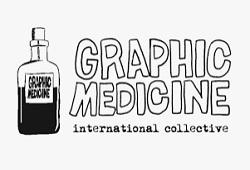
The first page of the 2015 Graphic Medicine Manifesto poses the question, “So what is ‘Graphic Medicine’?” In the panels that follow, illustrated versions of registered nurse MK Czerwiec, Dr. Ian Williams, medical professor Michael Green, and Susan Squier of the Pennsylvania State University offer interpretive answers to the query.
“It is the intersection of the medium of comics and the discourse of healthcare,” Czerwiec explains, to which Williams responds, “Graphic Medicine combines the principles of narrative medicine with an exploration of the visual systems of comic art, interrogating the representation of physical and emotion signs and symptoms with the medium.”
“It’s an approach to the education of health professionals, as well as an emerging area of interdisciplinary academic study,” Green adds, with Squier then chiming in, “Graphic Medicine is also a movement for change that challenges the dominant methods of scholarship in healthcare, offering a more inclusive perspective of medicine, illness, disability, caregiving, and being cared for. Comics give voice to those who are often not heard.”
In 2007, Ian Williams launched a website called Graphic Medicine to catalogue the growing number of comics that had ties to healthcare. The name of the website was intentionally vague in order to incorporate a broad range of examples, from graphic memoirs dealing with illnesses, educational comics, humorous comic strips referencing healthcare, and even therapeutic workshops that included the making of comics.
There were other medical professionals who shared Williams’ enthusiasm for what quickly became known as “Graphic Medicine,” many of whom were already working on their own initiatives, including Michael Green and Kimberly Williams from the Hershey branch of Penn State University.
Green was an internal medicine doctor who specialized in ethical issues surrounding healthcare, many of which arose due to poor communication between doctors and patients. Williams, meanwhile, was a literature professor who recognized that a person’s life story inevitably changed when faced with a major illness. Since their interests overlapped, Michael Green suggested to Kimberly Williams that the two of them write a paper on using comics as a way to better explain the effects of illnesses.
The subsequent article was not only published in the March 3, 2010, edition of The BMJ healthcare journal but made the cover as well, giving the emerging field further legitimacy. That same year, Ian Williams organized a Graphic Medicine Conference in London, with a second then taking place in Chicago in 2011. Similar conferences have been held every year since, with the location changing annually. (The 2021 “UnConvention” was held virtually due to the Covid-19 pandemic.)
Both the Graphic Medicine website launched by Ian Williams in 2007 and the Graphic Medicine Conferences were eventually merged into a non-profit Graphic Medicine International Collective in 2019, “a community of academics, health carers, authors, artists, and fans of comics and medicine.”
The Penn State University Press, meanwhile, had started producing books on Graphic Medicine a few years earlier, becoming the premier publisher in the field as a result. “For healthcare practitioners, patients, family members, and caregivers dealing with illness and disability, graphic narratives enlighten complicated or difficult experiences,” their website states. “They can also communicate the scaled meanings of health, from the molecular to the human and to the planetary, including works addressing climate change, environmental pollution, zoonotic diseases, and other complex problems not commonly conceptualized as ‘medical.’ For scholars in literary, cultural, and comics studies, the medium articulates a complex and powerful rethinking of the boundaries of medicine and the expansive meanings of health.”
The use of comics in healthcare not only helps patients in general but is especially effective when it comes to youths and non-English speaking segments of the population. Children who may have difficulty articulating the symptoms they are experiencing, for instance, often have an easier time drawing images reflecting their ailments. According to WebMD, meanwhile, only six percent of U.S. doctors consider themselves adept at speaking Spanish despite 18.9% of the population being Hispanic. Communicating via images thus cuts through the language barrier.
In addition to Penn State University and traditional comic book publishers, a host of other organizations likewise produce comic books in the field of Graphic Medicine. Booster Shot Comics, for instance, has created a number of illustrated publications geared towards children and their parents on asthma, allergies, and pain management. Even Marvel Comics has contributed to the field, publishing The Vitals: True Nurse Stories in 2020 that spotlighted the efforts of healthcare workers during the Covid-19 pandemic.
It’s not just within the United States that incorporating comics into healthcare is catching on. WebMD notes that a 2018 survey of medical students in India found that while 22% had never heard of Graphic Medicine, 77% believed comics would be useful as a teaching tool. In Norway, a social anthropologist was teamed with a graphic artist and people struggling with drug addictions to help educate the populace on the effects of illegal drugs and hepatitis C.
“Can reading comics help physicians better understand the patient experience?” Matthew Noe, lead librarian at the Harvard Medical School and board member of the Graphic Medicine International Collective, rhetorically asks on WebMD. “Can we really help build empathy through reading comics? These, and many more, are all questions explored in graphic medicine.”
Thanks to the work of the Graphic Medicine International Collective and an untold number of healthcare professionals across the country and around the world, the answers are not only coming into focus but pointing to a resounding “Yes!” as well.
Anthony Letizia

